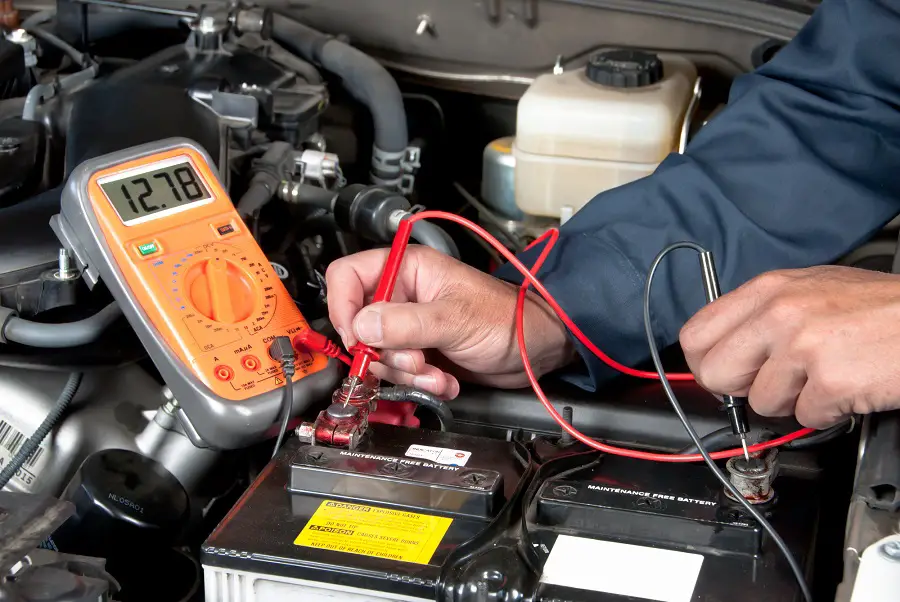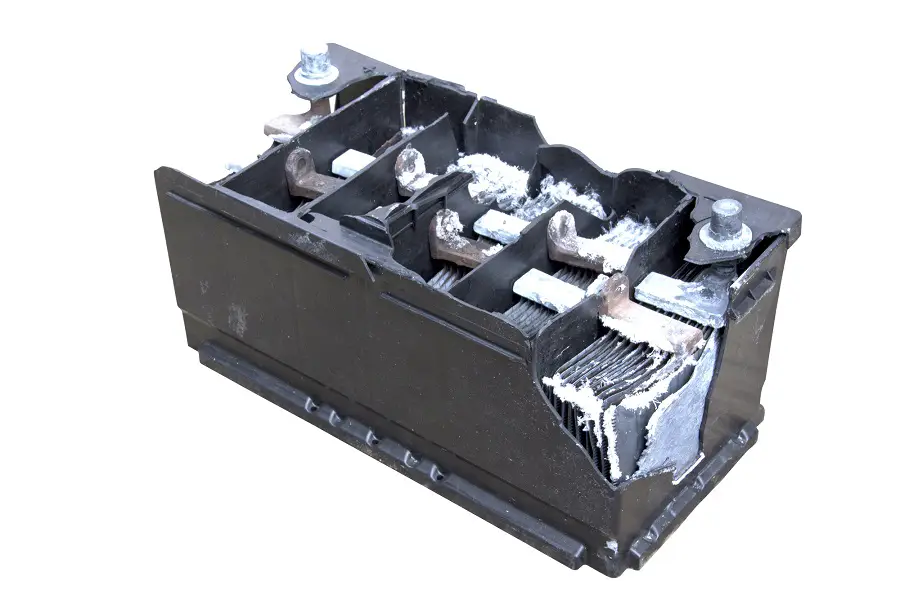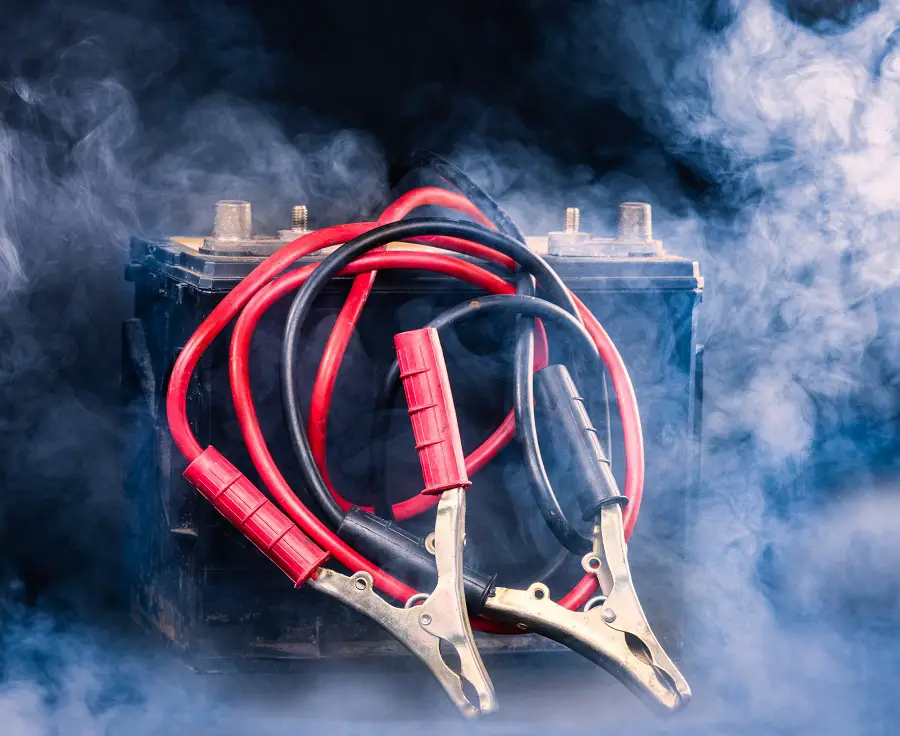We’re continuing with our car maintenance tips series and addressing how to check your car battery and replace it if it’s not functioning properly.
The whole idea of this series is “new driver” focused. Meaning, I’m writing these articles as a guide for someone who is a novice at repairs & maintenance.
As a household that has a brand new driver, as well as one that has someone who wants to start rebuilding cars, these articles are written for him. I’ll probably make him read these as homework. But they work for anyone else who drives and wants to learn how their car works.
They’re life lessons for drivers.
One of the most important life lessons is how to check and replace your car battery. If you don’t know how to replace your car battery, you could find yourself in a potentially dangerous situation. The quick answer is:
You can check if your battery is good by using a multimeter to read the voltage output. It should be around 12.66 volts when fully charged. You can also take it to a parts store to be tested. Replacing a battery is as simple as removing two cables and a hold-down.

Here’s everything you need to know about checking and replacing a car battery.
Why Is it Important to Know How to Check and Replace a Car Battery?
If you wonder why it’s essential to know how to check and replace a car battery, consider this. By learning how to check your car battery, you can avoid getting stranded on the roadside far from home. Or finding your inoperable car stuck in the garage when you need to get to work.
Imagine you are setting out on a trip to visit some old college buddies a few states away. While you were packing, your primary focus was on what clothes to bring, a toothbrush, and the usual stuff. By the time you climb into your vehicle, you’re so concerned about getting to your destination on time you don’t even think about checking your car battery.
After driving through town after town on your way to visit your friends, you stop to get a bite to eat at an inviting restaurant. By the time you get back into your car and attempt to start it, nothing happens.
Confused, you try starting the car again, but to no avail. By the time you give up, you try calling for help when you realize that you don’t know the phone number for any local towing services. When you try looking for the number online, you discover that you don’t have any service.
After walking back into the restaurant to ask for a phone book, you finally call a towing service and get your car towed to a local shop. After spending the night at a motel, you finally get to pick your car up and go on your merry way.
The lesson here is that all of this could have been avoided by simply checking your car battery before leaving home.
How to Check a Car Battery
When it comes to checking a car battery, it’s usually something that is done sooner rather than later. No one wants to break down and get stuck on the side of the road all day because of a dead battery.
Signs That Your Battery May Be Going Bad
There are a few early warning signs that your battery may be dying. Here are a few:
- The car starts more slowly over time. The starter may sound “sluggish” or like it’s struggling to turn the engine over.
- Your accessories reset. If your battery isn’t holding enough charge, your radio or other programmed features may reset.
- You find your battery dead on a cold morning. After getting a jump, everything seems fine. But the next cold morning it does it again.
- Your battery is more than 4 years old. This time can be shortened if you live in a climate that has big swings between hot & cold (like we have where we live in Colorado) or extreme temperatures – either really hot or cold weather.
- Your Check Engine Light is on or you have a “low battery” code. This one is usually a dead giveaway!
- There is a visible leak or crack on the battery. If it’s cracked or leaking you will probably experience failure soon or won’t have enough power to start when it gets cold.
- Your headlights get brighter as you rev your engine. This means that you’re pulling power primarily from the alternator instead of the battery. Your headlights should remain that same brightness at all times – even when stopped or powered off.
What you Need
To check your battery, you’ll need safety goggles, gloves, a digital multimeter and maybe some shop towels. Ideally, keep a kit containing these items in your car at all times so you can check your battery when you’re out of town or on the road.
You’ll also need to be in a safe place that’s away from traffic. NEVER try and work on your car just off of a busy road or anywhere where you may be clipped by a distracted motorist.
The multimeter needs to be set to 20 volts DC – for most multimeters, this is the section of your that has the abbreviation V on it. Make sure your leads are plugged in to the correct ports
Where is the Battery in the Car
Your first challenge is to find the battery. Although the majority of vehicles have batteries located under the hood near one of the fenders, there are some models that put the battery under the back seat, the trunk or in the wheel well.
When in doubt, check your owner’s manual for directions, as it will tell you exactly where the battery is located. Once you find the battery, you’ll need to turn off the lights and ignition, if they aren’t already off.
The next thing is connecting the black lead on your digital multimeter to the negative battery terminal, and then connect the red lead to the positive battery terminal. Try to test on the terminal itself, not the cables in order to rule out the battery and not a poor connection or bad cable.
If you’re having trouble, just remember that red goes with red and black goes with black.
Pro Tip
Cable colors aren’t always correct.
As someone who has worked on enough cars that have been “repaired” over the years, you can’t always trust the cable colors on older cars. To confirm your cable colors match, as they should, you can confirm that the red cable is connected to the “+” on the battery (positive terminal) and the black is connected to the “-” (negative terminal).
All batteries will have some sort of label to identify the positive and negative terminals.
I’ve seen and have personally used an extra black battery cable I had lying around to connect to the positive side of the battery. If I didn’t remember this (or someone was giving me a jump who didn’t know this) it would be very possible to connect the battery incorrectly and potentially cause damage.
It’s best to double-check – measure twice and cut once as they say.
How many volts should a car battery have when fully charged?
Finally, switch the voltage to DC and examine the reading. A reading of around 12.66 volts means that your battery is 100% charged.
When the engine is running, a car battery should measure between 13.7-14.7 volts when it’s fully charged. But don’t check the battery when the car is running – as this is more of a test of the alternator and not the battery.
Anything lower than 12.66 volts means your battery is not fully charged or is not holding a charge (or it can mean that the weather is impacting the voltage the battery has). On a day that is 80 degrees Fahrenheit, a reading of 11.89 volts means your battery is 100% dead, or 0%. Therefore, anything 12.45 volts or above is A-okay!
How to Replace a Car Battery
Now that you know how to check a car battery, it’s time to learn how to replace one. There are a few basic steps to replacing a car battery – first and foremost is buying a replacement. There’s no point in taking a bad battery out if you don’t have something to put in its place.
Buying a New Battery
You’ll want to replace your battery with the same size that’s already in it. You can find this in your owner’s manual or by looking online (or in “the book” at the parts store).
Batteries are coded by SIZE, just like small batteries that go in your electronic devices (AA, AAA, D, etc.), car battery sizing is numerical or alpha-numeric in most cases – like 25, 48, 75F, H7, etc. Make sure you get the correct size.
You can have different CCA’s than the battery you’re replacing (and sometimes it’s recommended if you live in a colder environment or your engine has higher compression).
CCA refers to Cold Cranking Amps – this is the power output the battery can put out when in cold weather. The higher the number, the “stronger” the battery.
PRO Tip
Even if you buy the right “size” battery by checking the physical dimensions, you may still have the wrong one. It may have the wrong terminals (top post vs. side post) or they may be in the wrong spot for your connections.
The positive and negative terminals can be flipped on different batteries. Or on the opposite side of the battery (so your cables aren’t long enough to connect). Make sure you’re getting the correct battery for your vehicle by verifying the numbers, but also do a physical inspection before purchase to make sure it will work.
Core Charge Gotcha
One of the first things you should know about replacing a car battery is the core charge you pay when buying a new car battery.
That core charge is essentially a form of a deposit that is paid on new batteries. About 30 out of the 50 states in the US. require vendors to issue core charges by law when selling car batteries. The important thing is that since core charges are essentially deposits designed to encourage recycling, you can get that money back when you bring your old battery in. (We did a battery core charge deep dive in this article.)
Remove the Old Battery
The first step when replacing a car battery is to disconnect the positive and negative battery cables. You’ll need a ratchet to remove the clamp on the top post (usually at 10mm) and an 8mm ratchet to remove the fastener on a battery that has side posts.
Remove Positive or Negative First?
Remove the negative terminal first, followed by the positive cable. This avoids accidentally shorting the battery to ground when removing the positive terminal. If you remove the negative first then the battery isn’t grounded to the car.
Use caution when working around your battery terminals as touching both at the same time can shock you or fry electronics.
Your next challenge will be to remove the restraint holding the battery in place. Once the restraint is removed successfully, you can put the battery aside in a clear area.
Sometimes the hold-down has a long hooked bolt and strap that goes over the battery and sometimes it’s just a small clamp that compresses the tab at the base of the battery to the battery tray. Removing the restraint is often the hardest and most time-consuming part of replacing a battery.
Clean Up the Space
The next step requires a face mask to prevent unintentional inhalation of corrosive substances and dirt. You’ll also need a wire brush to scrub away all the corrosion and dirt off of the ends of your battery cables and the terminals.
Ideally, the ends of your battery cables and terminals should be as clean as possible. Once you have cleaned everything thoroughly, you can apply some terminal grease (dielectric grease) to the battery posts on the new battery.
If you’re feeling “spendy” you can opt for the little felt rings that go on the posts as well – they aren’t necessary, but they keep the area clean – for a while.
Although there are several possible methods for installing a new car battery, most basic principles remain the same. Different models require different methods, but for the most part, all you need to do is place the new battery into the original housing and connect the cables correctly.
Installing a New Car Battery
Before you install your replacement battery, take a look at it to make sure it’s clean and in good condition. There will be two plastic caps, one on each terminal, on your new battery (at least, there should be). You will have to remove these caps. There may also be some additional covers that you will have to remove before installing the battery properly.
Once everything is removed, you can lower the battery into place. Verify the connections are all correct (be cautious to not touch the cables to the live battery until you’re ready to tighten everything down).
After putting the new battery securely in the original housing in your vehicle, you will be ready to put the restraints back on. Whether it’s a strap or a bar, you must put the restraint back on.
When you put the cables back on, you do it in the opposite order from when you took it off. Positive first then the negative cable. The same principle applies as before – you want the battery to NOT be grounded when you’re messing with the positive side. This helps avoid you getting shocked or shorting out the car’s electrical components.
Using a wrench or socket, tighten the bolts that secure the cable to the terminal. After the red cable (positive) is attached, you can take the black cable (negative) and attach it to the corresponding terminal. Tighten it just like you did with the positive connection.
Here’s the fun part! After following all of the steps mentioned above, you will finally get to test your battery by starting your car! If you followed instructions and everything went well, your vehicle should start right up without any problems.
If you see smoke or smell melting electronics you need to quickly disconnect the battery again (negative first, then positive) and check your terminals. Make sure you didn’t flip the polarity or that something isn’t touching the positive post causing it to ground to the car or frame.
Car Battery Replacement Cost
The car battery replacement cost depends on the size of the battery you need for your vehicle. The average car battery replacement cost ranges between $60 to $150. A good rule of thumb is to replace your dead battery with one that is the same (size, CCA, brand) or better (higher CCA for example).
But you can save some money by installing a generic battery as we proved recently they’re just as good, if not identical, to some of the name-brand batteries.
While the new battery cost average is under $150, it is much less than the cost of repairs from having a traffic accident that could have been avoided by replacing your battery. Since the new battery cost average is relatively low, new car batteries are very affordable.
Keep in mind that some car batteries can cost as much as $200. If you own a racing car or use a car for racing, your battery may cost more than a battery for an average vehicle. And sometimes you have to buy two of them (or more).
Other Things to Keep in Mind When Replacing a Car Battery
Any time that you are replacing a car battery, there are some things that you should keep in mind. Your first priority should be safety, as changing a car battery is dangerous if you do it improperly.
Batteries are HEAVY. Use caution when lifting it out, transporting it or “setting it to the side”. Don’t try and balance it on your bumper. You’re on your way to a smashed toe or worse.
Another thing to is that you should always disconnect the negative battery cable whenever you are working on electrical components in the vehicle. By disconnecting the negative battery cable before working on any electrical components in your vehicle, you will dramatically reduce the risk of grounding or arcing if you pierce a wire.
Grounding out electrical components can do MAJOR damage to newer cars as they’re mostly computers. This can be a costly repair, as I found out when I shorted the battery in my Volvo, to the tune of $6000 or more! That was an expensive “dead battery”.
Why You Should Always Wear Safety Gear When Replacing a Car Battery
Car batteries contain a corrosive substance known as sulfuric acid. When you are replacing a car battery, it’s essential to wear safety gear that ensures adequate protection from sulfuric acid. Failing to protect yourself from accidental exposure to sulfuric acid can result in serious injuries or medical issues.
Why is it so important to wear safety gear to protect yourself from battery acid? It’s important because sulfuric acid can burn through human skin and cause blindness. That’s why you should always wear safety goggles, gloves, and any other gear that can help shield you from sulfuric acid.
Terminus
Most cars experience electrical gremlins at some point in their life. Ruling out, or testing, the battery is usually one of the first things you need to do when troubleshooting any issues.
Some professional mechanics recommend load testing your batteries every couple of years. This will pre-empt finding yourself stranded due to a dead battery, we think this is prudent.
These tips should keep you on the road and moving. If nothing else, after reading all of this, your brain is probably fully charged.






